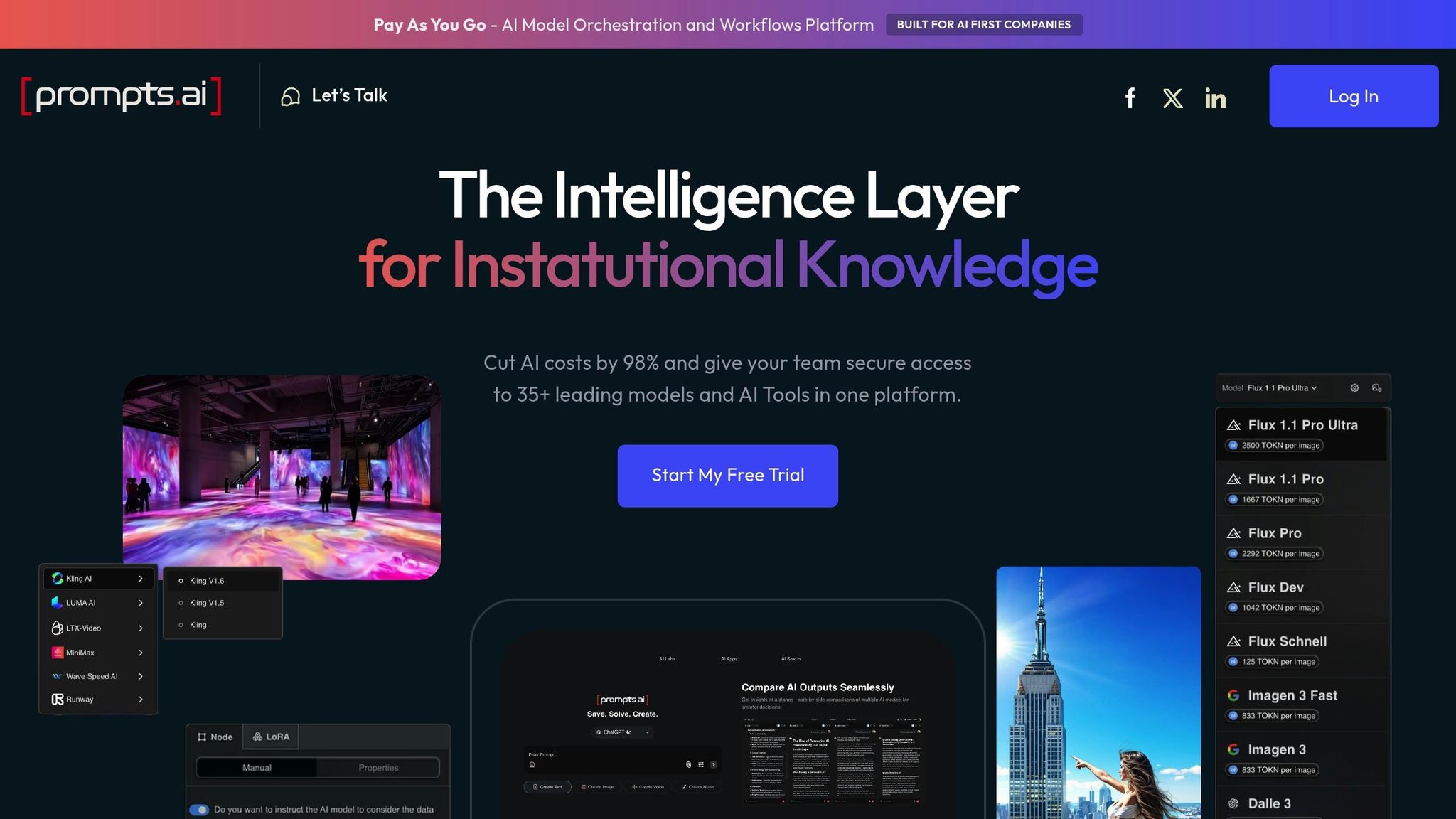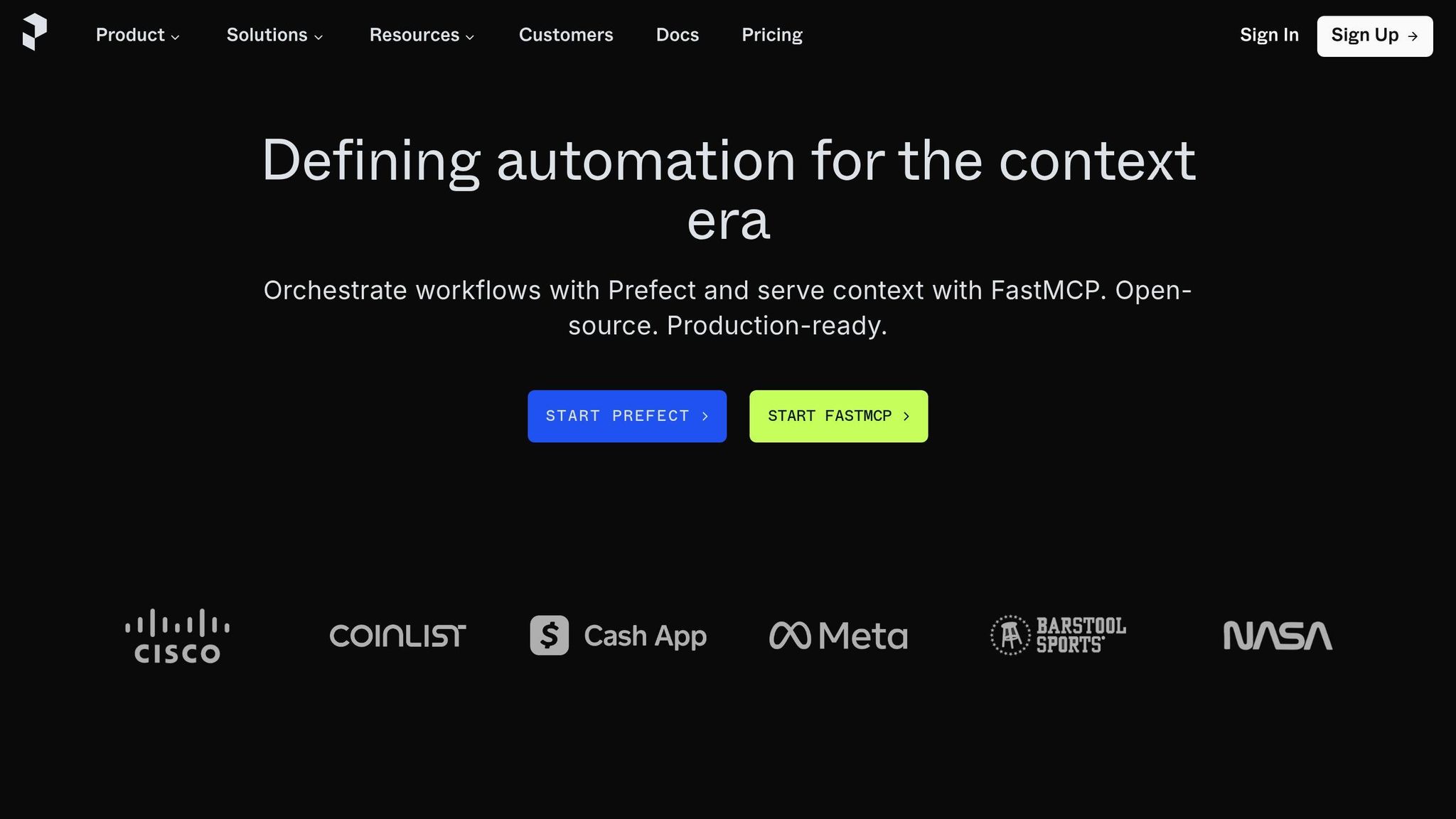
Machine learning workflows are complex, involving tasks like data prep, model training, and deployment. Orchestration frameworks simplify this process by automating and managing these steps to save time and reduce errors. Here's a quick breakdown of four leading frameworks:
| Framework | Key Features | Limitations | Best For |
|---|---|---|---|
| Prompts.ai | Unified AI models, cost tracking | Focused on prompt orchestration | Generative AI and prompt workflows |
| Apache Airflow | DAG-based workflows, large community | Steep learning curve, complex setup | Batch processing and enterprise pipelines |
| Kubeflow | Kubernetes-native, distributed ML | Requires Kubernetes knowledge | Distributed workloads, cloud-native ML |
| Prefect | Python-first, real-time monitoring | Smaller ecosystem, scaling challenges | Agile teams and rapid development |
Each framework serves specific needs. Choose based on your team's expertise, project complexity, and scalability requirements.

Prompts.ai is an enterprise-grade AI orchestration platform that brings together over 35 leading language models into a single, unified interface. Unlike typical frameworks that focus only on workflows, Prompts.ai combines machine learning orchestration with cost management and advanced governance tools.
Prompts.ai is designed to grow with your needs. Its unified model architecture eliminates the confusion of managing multiple tools, enabling organizations to scale AI operations effortlessly. Whether adding new models, expanding teams, or increasing users, the platform ensures a smooth process without operational headaches. Higher-tier plans offer perks like unlimited workspaces, up to 99 collaborators on the Problem Solver tier, and unlimited workflow creation, making it ideal for large-scale AI initiatives.
The platform’s pay-as-you-go TOKN credit system redefines AI costs, aligning expenses with actual usage. This on-demand model allows teams to expand their machine learning capabilities without the burden of increased infrastructure complexity. It integrates seamlessly with existing systems, ensuring scalability without disruption.
Prompts.ai excels in interoperability by offering connectors and APIs that integrate effortlessly with existing tech ecosystems. Its side-by-side model comparison feature allows teams to evaluate and optimize performance within a single interface, ensuring the best model is chosen for specific needs.
Governance is a core focus of Prompts.ai, providing features like built-in audit trails, real-time usage tracking, and detailed spend monitoring. The platform delivers real-time metrics for every model and prompt, ensuring transparency. With role-based access controls and robust security measures, teams can enforce compliance while enabling seamless collaboration on AI projects.
Deploying Prompts.ai is straightforward, thanks to its user-friendly interface. The platform simplifies traditionally complex machine learning orchestration, enabling teams to set up secure, compliant workflows in just minutes. Intuitive onboarding and enterprise training ensure a smooth start, while features like the Prompt Engineer Certification and expert 'Time Savers' help teams adopt best practices from day one.
Steven Simmons, CEO & Founder, shared how Prompts.ai's LoRAs and workflows allowed him to complete 3D renders and business proposals in a single day - a process that previously took weeks for renders and a month for proposals. This not only saved time but also eliminated the need for costly hardware upgrades.
With an average user rating of 4.8/5, Prompts.ai is widely praised for its ability to centralize project communications, automate operations, and handle complex tasks efficiently.

Apache Airflow has earned its place as one of the most established open-source orchestration frameworks. Originally developed at Airbnb and maintained by the Apache Software Foundation since 2016, it has become a go-to tool for managing data and AI workflows. At its core, Airflow uses Directed Acyclic Graphs (DAGs) to structure machine learning tasks, making even the most intricate pipeline dependencies clear and manageable.
What makes Airflow particularly effective is its Python-based configuration system. Teams can design workflows as code, enabling version control, testing, and collaborative development. This approach transforms machine learning pipelines into assets that are easier to manage and scale. Airflow is widely used to coordinate tasks like machine learning training, AI model deployment, and retrieval-augmented generation workflows.
Airflow's modular design ensures it can scale to meet the needs of organizations both large and small. It integrates seamlessly with major cloud providers like AWS, Google Cloud Platform, and Microsoft Azure, making it a strong choice for hybrid or multi-cloud setups.
As machine learning operations grow, Airflow’s dynamic pipeline generation capabilities allow it to handle increased workloads and adapt to more complex requirements effortlessly.
One of Airflow's standout features is its ability to integrate with a wide range of tools and platforms. Its extensive library of community-built connectors and operators supports various data processing systems. Thanks to its Python foundation, Airflow can work with virtually any platform that offers Python APIs, making it a versatile choice for diverse technology environments.
Recent updates have further enhanced Airflow’s role in AI workflows. With the addition of a LangChain provider, users can now trigger agent runs, monitor tools, and schedule context updates directly within a DAG. This level of integration not only boosts functionality but also sets the groundwork for improved workflow oversight.
Airflow’s workflow-as-code approach provides a solid framework for governance. By defining pipelines in Python, teams can leverage version control, conduct code reviews, and collaborate effectively, ensuring consistency and accountability. The DAG structure also offers clear execution paths, making dependencies and data lineage easy to trace - an important feature for compliance and troubleshooting complex workflows.
While Airflow delivers powerful orchestration capabilities, setting it up does require technical expertise. Teams must handle installation, configuration, and ongoing maintenance, which can be more demanding compared to commercial platforms. However, this complexity comes with a major advantage: full control over orchestration pipelines. Airflow’s extensive libraries also offer flexibility, catering to varying levels of technical proficiency within teams.

Kubeflow, an open-source machine learning platform developed by Google, is built specifically for Kubernetes. It’s designed to address challenges across the entire machine learning lifecycle, from data preparation and model training to deployment and monitoring. With its container-first architecture, Kubeflow ensures portability and reproducibility, making it a strong choice for organizations looking to scale their ML operations. Rather than replacing existing tools, it integrates seamlessly, enhancing established workflows.
Built on Kubernetes, Kubeflow is well-suited for distributed training, allowing large machine learning jobs to be divided across multiple nodes. This capability is particularly valuable for deep learning projects that require significant computational resources. Additionally, Kubeflow optimizes resource utilization, ensuring efficiency even during idle periods. Its design goes beyond scaling, offering smooth integration with a variety of systems to support complex workflows.
Kubeflow works seamlessly with existing tools and platforms, making it a versatile addition to established ML ecosystems. For example, it integrates with popular workflow systems like Apache Airflow, enabling teams to incorporate Kubeflow components into their current orchestration setups.
The platform also excels in cloud compatibility, supporting major providers such as Amazon Web Services (AWS), Google Cloud Platform (GCP), and Microsoft Azure. This multi-cloud support allows organizations to avoid vendor lock-in while taking advantage of the best features each provider offers.
Kubeflow’s containerized architecture further enhances interoperability by relying on standardized container orchestration. Teams can package their ML code, dependencies, and configurations into containers, ensuring consistent performance across environments, from local development to production clusters.
Additionally, tools like Kale streamline the process of converting Jupyter Notebooks into Kubeflow Pipelines workflows. With native features for experiment tracking and workflow organization, Kubeflow enables data scientists to transition smoothly from research to production-ready pipelines.
Deploying Kubeflow requires expertise in Kubernetes, which can pose a challenge for teams unfamiliar with container orchestration. The platform assumes knowledge of concepts like pods, services, and deployments. However, once set up, Kubeflow delivers a powerful infrastructure for managing models in production. It includes APIs that support integration with model management tools like MLflow and TensorFlow Serving. While the learning curve may be steep, Kubeflow provides a solid framework for scaling machine learning operations effectively.

Prefect is a modern workflow orchestration platform designed with developers in mind, offering a smooth and intuitive experience. Unlike older, more rigid workflow tools, Prefect adopts a code-first approach that fits naturally into the workflows of data scientists and machine learning (ML) engineers. By allowing developers to write workflows in pure Python, Prefect handles the complexities of orchestration behind the scenes, freeing teams to focus on their ML logic.
With its streamlined design, Prefect reduces the overhead associated with orchestration, making it an excellent choice for teams that want to avoid the steep learning curve of complex scheduling systems. Let’s delve into how Prefect supports scalable, robust operations.
Prefect’s architecture is built to scale effortlessly, supporting both horizontal and vertical scaling through its flexible execution model. Whether you're working on a single laptop or managing large-scale cloud clusters, Prefect adapts to your computational needs with ease.
The Prefect Cloud service takes this a step further by offering automatic scaling, capable of handling thousands of concurrent workflows. For organizations with fluctuating ML workloads, this means you can handle large-scale batch jobs during peak times and scale down during quieter periods - all without manual adjustments.
Prefect also enables task-level parallelization, allowing individual steps within an ML pipeline to run simultaneously across multiple workers. This is especially useful for data preprocessing tasks that can be distributed across cores or machines, significantly cutting down pipeline execution times.
Prefect integrates seamlessly with the Python ecosystem, making it a natural fit for most machine learning stacks. Workflows are written in standard Python, so you can use popular libraries like scikit-learn and TensorFlow without needing extra adapters or special configurations.
The platform also offers native integrations with major cloud providers, including AWS, Google Cloud Platform, and Microsoft Azure. These integrations simplify authentication and resource management. Additionally, Prefect’s built-in Docker support ensures workflows run consistently across development, testing, and production environments, streamlining deployment.
Prefect extends its interoperability with REST APIs and webhooks, allowing it to connect easily with external systems such as model registries, CI/CD pipelines, and monitoring tools. This flexibility makes it simple to trigger workflows from other applications or embed Prefect into existing automation workflows.
Prefect doesn’t just focus on operational efficiency - it also emphasizes secure and auditable workflow management. Every workflow execution and parameter change is logged, providing a clear audit trail, which is especially important in regulated industries.
The platform’s role-based access control (RBAC) allows administrators to assign specific permissions to team members. For instance, data scientists can run experiments, while ML engineers retain control over deployments to production, ensuring clear separation of responsibilities.
Prefect also integrates with version control systems, automatically tracking changes to workflow definitions. This feature makes it easy to monitor how pipelines evolve over time. Additionally, Prefect supports running multiple versions of the same workflow simultaneously, enabling safe experimentation and gradual rollouts of updates.
Prefect makes deployment simple and flexible, offering options to suit a variety of organizational needs. The Prefect Cloud service eliminates the hassle of managing infrastructure - teams can get workflows running in just minutes with a Python package installation and API key setup.
For organizations that prefer self-hosted solutions, Prefect Server can be deployed with a single Docker Compose command. This setup handles scheduling, monitoring, and coordination, while tasks can run anywhere - on local machines, cloud instances, or container orchestration platforms.
Prefect also offers a hybrid model, where metadata is managed in Prefect Cloud, while ML code and data remain on your infrastructure. This approach combines the convenience of managed services with the security of on-premises data handling.
With its Python-first design, Prefect is easy to adopt. Unlike tools that require learning domain-specific languages or managing complex YAML configurations, Prefect workflows feel like ordinary Python scripts - just enhanced with orchestration capabilities.
This section provides a comparison of machine learning orchestration frameworks, focusing on their strengths, weaknesses, and ideal use cases. Each framework brings its own set of benefits and challenges, making it essential for teams to weigh these factors against their technical expertise, organizational goals, and specific project needs.
Prompts.ai stands out for its streamlined approach to prompt orchestration, offering unified access to over 35 leading AI models. This eliminates the hassle of managing multiple tools and ensures robust security with its SOC 2 Type II certification, making it a strong choice for organizations handling sensitive data. However, its specialization in prompt orchestration means it’s less suited for broader machine learning workflows. Additionally, its smaller, niche community may present challenges for resolving more complex issues.
Apache Airflow is highly regarded for its structured, batch-oriented workflows and extensive customization capabilities, supported by its DAG-based approach. With over 20,000 GitHub stars and adoption by major companies like Airbnb, Netflix, and PayPal, it offers a mature ecosystem. That said, its steep learning curve and the overhead involved in setup and maintenance can make it less ideal for dynamic machine learning pipelines that extend beyond traditional batch processing.
Kubeflow is a go-to for teams with Kubernetes expertise, offering a cloud-native design that supports seamless scaling and deep integration across the machine learning lifecycle. It’s used by organizations like Google, IBM, and SAP for distributed ML workloads requiring enterprise-level scalability. However, its complexity, demanding setup, and higher resource requirements mean that a solid grasp of Kubernetes is essential to fully leverage its potential.
Prefect addresses usability concerns found in traditional orchestration frameworks with its Python-first approach, dynamic workflows, and real-time observability. These features make it particularly appealing for teams focused on ease of use and rapid iteration. While Prefect’s community is growing, with over 5,000 GitHub stars, its ecosystem is not as extensive as Airflow’s, and scaling to enterprise-level deployments can be a challenge.
To help guide your selection, the table below highlights the key strengths, limitations, and ideal use cases for each framework:
| Framework | Key Strengths | Primary Limitations | Best For |
|---|---|---|---|
| Prompts.ai | Unified AI model access, enterprise-grade security | Limited to prompt orchestration, smaller community | Generative AI workflows and prompt engineering projects |
| Apache Airflow | Mature ecosystem, robust scheduling, large community | Steep learning curve, complex setup | Structured batch processing and enterprise data pipelines |
| Kubeflow | Kubernetes-native scaling, ML lifecycle integration | High complexity, requires Kubernetes expertise | Cloud-native environments and distributed ML workloads |
| Prefect | Dynamic workflows, real-time monitoring | Smaller community, limited enterprise scaling | Teams prioritizing usability and rapid development cycles |
When considering costs, Prompts.ai and Prefect generally offer lower barriers to entry through cloud-hosted and pay-as-you-go pricing models. On the other hand, Apache Airflow and Kubeflow often require significant infrastructure investments and specialized personnel. Beyond licensing costs, factors like training, maintenance, and operational overhead should also be part of the decision-making process.
Each framework brings distinct advantages tailored to specific machine learning workflows. The key is selecting the one that aligns with your team's expertise, priorities, and objectives.
For those focused on generative AI and prompt engineering, Prompts.ai simplifies operations with unified access to over 35 AI models and a flexible pay-as-you-go TOKN credit system, offering potential cost reductions of up to 98%.
Apache Airflow provides a robust and customizable solution for enterprise-scale data pipelines. However, it comes with a steeper learning curve and requires a more complex setup.
Kubeflow is ideal for teams well-versed in Kubernetes, delivering smooth scaling and comprehensive ML lifecycle integration. That said, it does demand significant infrastructure resources and expertise.
For a more agile and Python-centric approach, Prefect supports dynamic workflows and rapid iteration, though its ecosystem is comparatively smaller.
Ultimately, your decision should weigh factors like scalability, interoperability, governance, and deployment ease - not just licensing costs. By considering both immediate requirements and long-term goals, you can choose the framework that best supports your AI strategy.
Prompts.ai's pay-as-you-go TOKN credit system offers a straightforward way for organizations to access AI services without unnecessary costs. With this model, you only pay for the resources you use - no upfront commitments, no wasted spending.
The system is designed to grow with you. As your AI demands increase, you can effortlessly add more credits to meet evolving needs. This ensures your organization can scale efficiently without stretching budgets, making it an ideal choice for startups and established enterprises aiming to manage AI expenses while staying flexible.
For teams seeking simplicity and fast deployment, Prefect stands out with its intuitive interface and easy setup. Its modern design reduces the learning curve, making it a solid choice for those who want to get up and running quickly without dealing with complex configurations.
On the other hand, while Apache Airflow is a robust and widely recognized tool, it often demands more effort to configure and maintain. This can be a challenge for smaller teams or those new to orchestration tools. Prefect’s focus on user-friendliness and adaptability makes it especially attractive for teams that value speed and minimal setup requirements.
Kubeflow is a strong option for teams well-versed in Kubernetes, as it builds on Kubernetes' features to simplify distributed machine learning workflows. It enables you to create, deploy, and manage ML pipelines within a containerized setup, ensuring both scalability and dependability.
A standout feature of Kubeflow is its smooth integration with widely used ML tools and frameworks, which helps streamline the orchestration of complex workflows. For teams already skilled in Kubernetes, Kubeflow minimizes the need for additional training while offering solid support for distributed training, hyperparameter tuning, and model serving.


